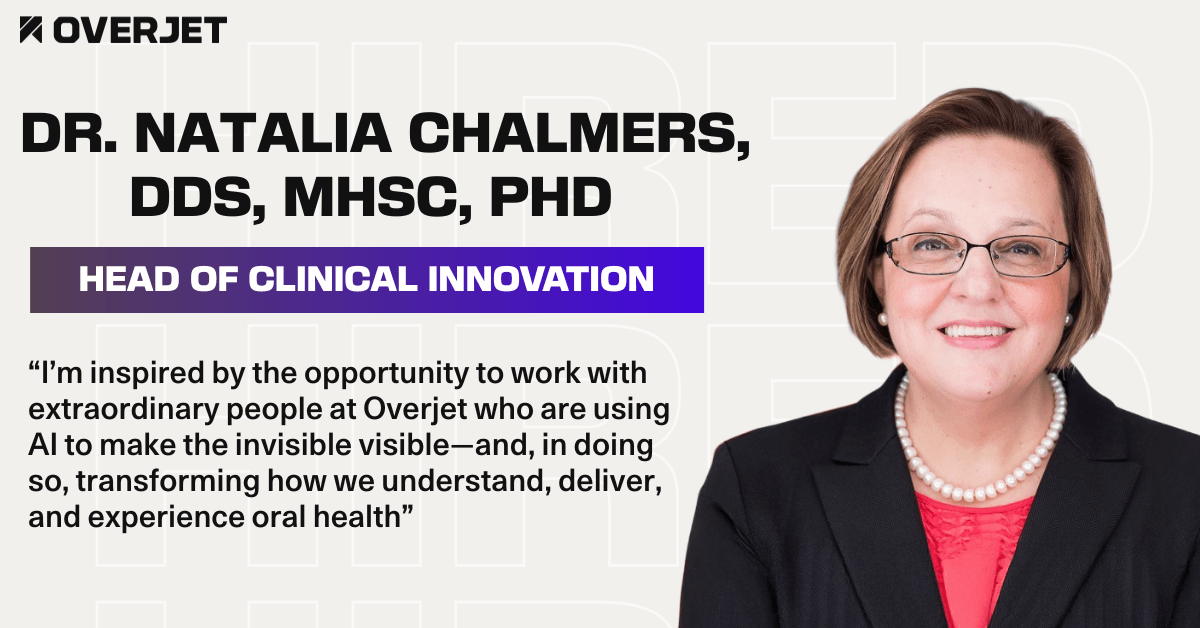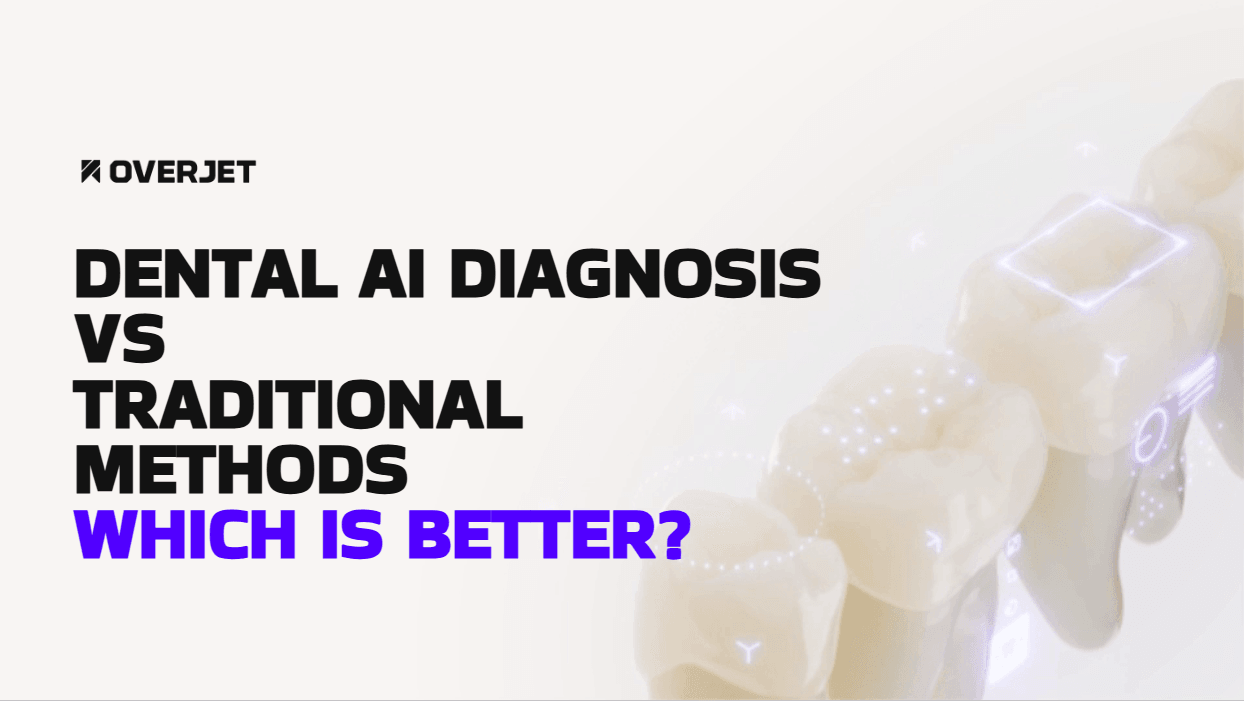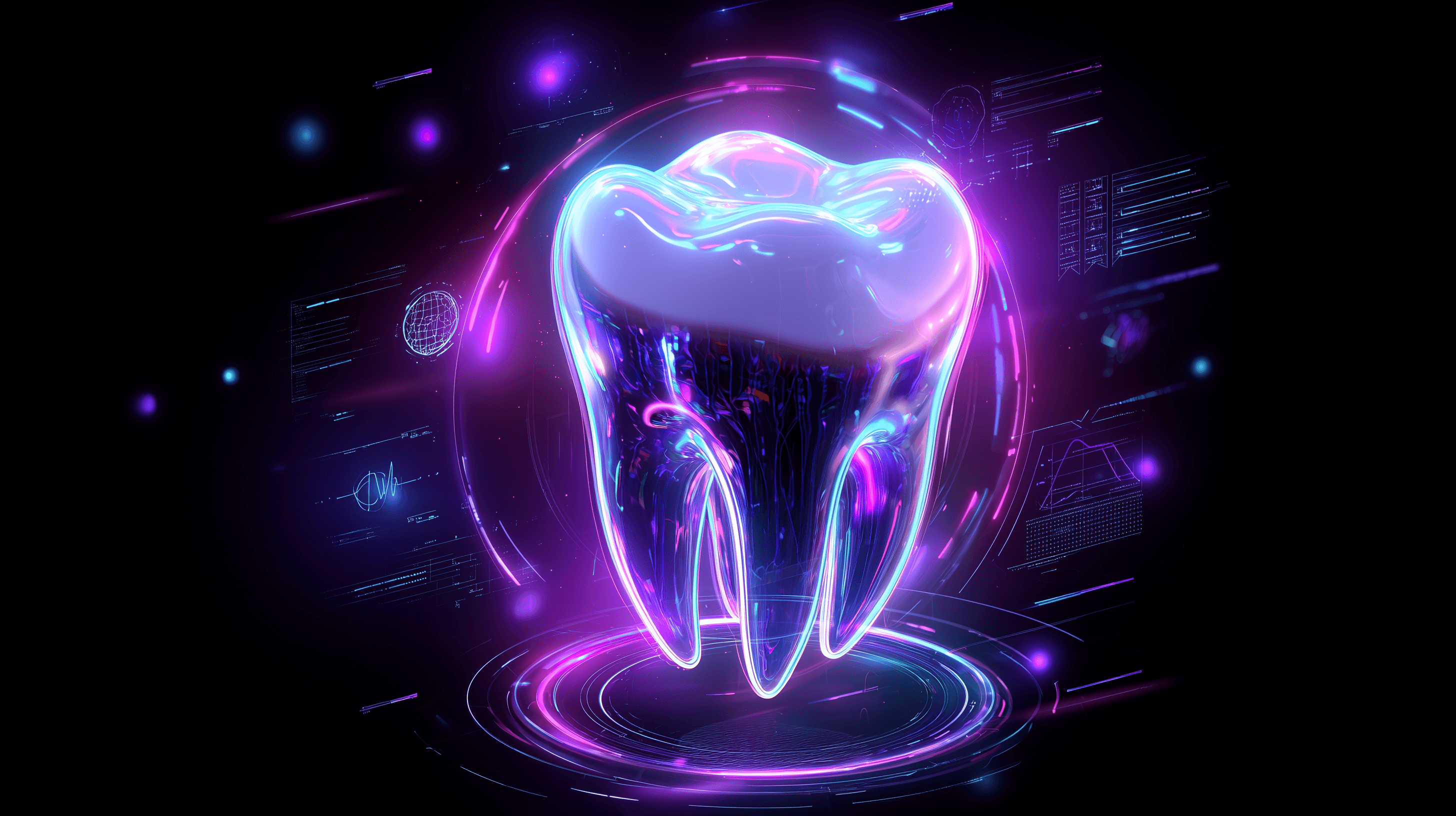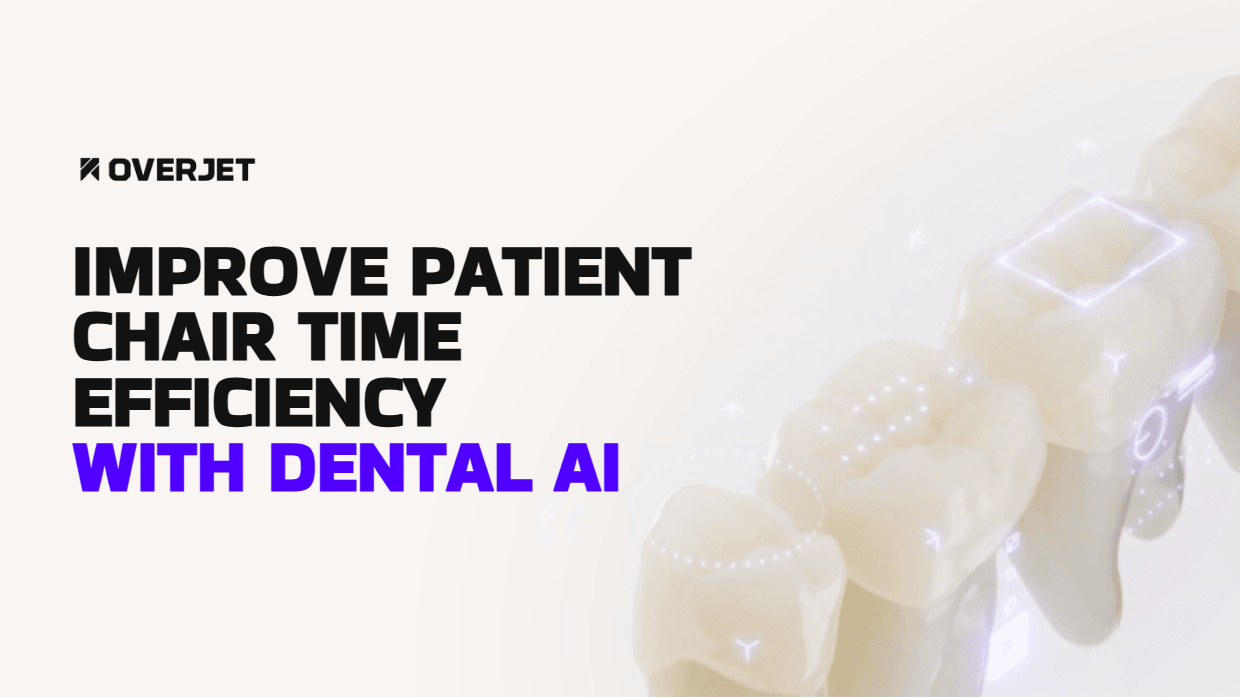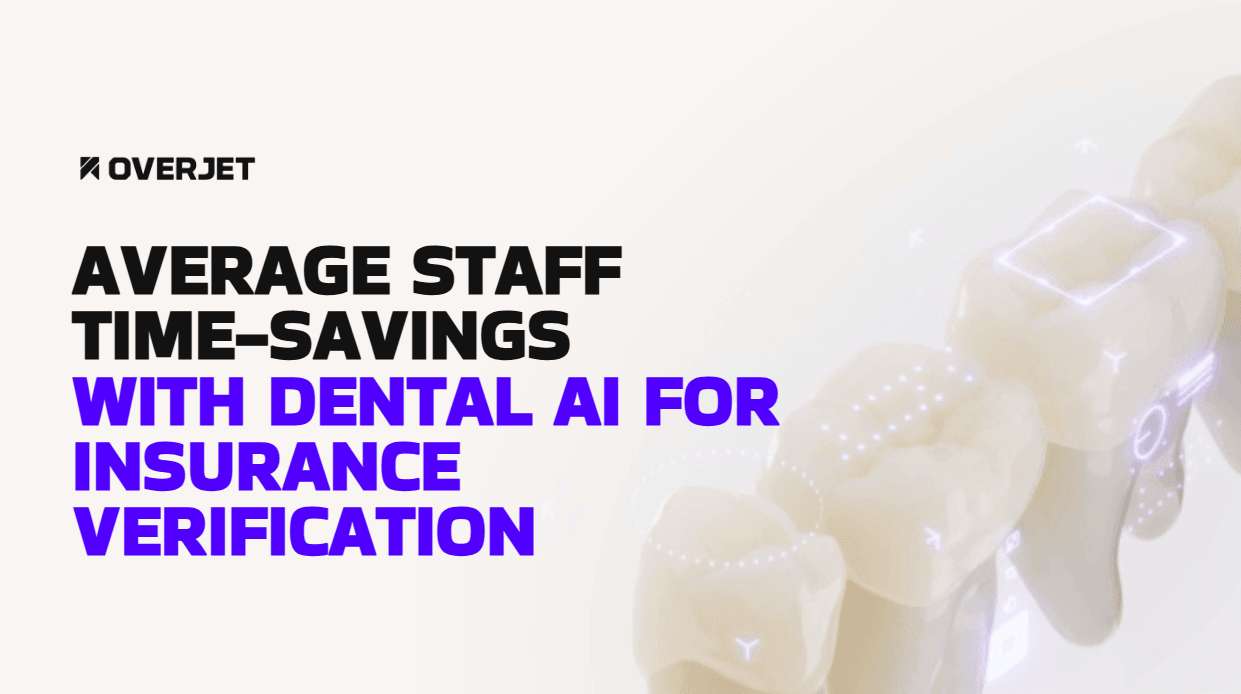General dentists spend significant time per patient reviewing radiographs, documenting findings, and explaining pathology.
Studies show that dentists miss fewer carious teeth when using AI assistance for radiographic analysis.
Explore Overjet's Dental AI Software
Quantified Time Savings From AI-Powered X-Ray Workflows
AI platforms such as Overjet are designed to analyze dental radiographs rapidly, often processing images in seconds.
1. Average Chair-Time Reduction Per Patient
Traditional radiographic workflows require dentists to review each image systematically, catalog findings mentally, annotate areas of concern, and document everything in the chart. AI removes most of this manual work through instant analysis.
The time savings come from three areas:
Instant pathology detection: AI highlights decay and bone loss within seconds, removing the need to search through images manually
Automated charting: Detected findings export directly to the patient record, eliminating transcription time
Visual patient education: Color-coded annotations reduce explanation time while improving patient comprehension
2. Daily Minutes Recovered in a Three-Op General Practice
Consider a multi-operatory practice seeing numerous patients daily across multiple providers.
Workflow Step | Traditional Time | AI-Assisted Time | Time Saved |
Image capture and quality check | 3-5 minutes | 2-3 minutes | 1-2 minutes |
Radiographic interpretation | 5-8 minutes | 1-2 minutes | 4-6 minutes |
Charting and documentation | 3-5 minutes | 30 seconds | 2.5-4.5 minutes |
Patient education | 5-10 minutes | 2-4 minutes | 3-6 minutes |
This additional clinical capacity allows practices to see more patients or allocate time more efficiently.
3. Annual Revenue Potential From Added Procedure Slots
Expanded daily capacity creates room for additional patient visits annually. Even if only a portion of these slots are filled, practices can see significant revenue increases.
Overjet users often see increases in patient volume within six months of implementation. The revenue comes not from working longer hours, but from eliminating inefficiency in existing workflows.
Where General Dentists Lose the Most Minutes in Traditional Radiography
Most practices underestimate how much time accumulates across small delays throughout the day. Three areas create the biggest bottlenecks in traditional radiographic workflows.
Capture and Retake Cycles
Poor image quality forces complete recapture, adding 3-5 minutes to each affected appointment. When quality issues occur, traditional workflows often discover problems after the patient has left the chair.
Common issues include positioning errors that cut off anatomical structures, exposure problems that obscure pathology, and motion artifacts from patient movement. AI systems provide instant quality assessment during capture, alerting staff to issues before the image gets stored. This real-time feedback eliminates most retakes, saving practices 45-60 minutes daily.
Manual Charting and Annotation
Documenting radiographic findings consumes 3-5 minutes per patient—time that multiplies across dozens of daily encounters. The process involves mentally cataloging each pathology, marking it on the image, and transcribing findings into the patient record with proper clinical terminology.
Dentists often complete charting between appointments or during lunch. Overjet’s automated charting removes this bottleneck entirely by exporting detected pathologies directly into practice management systems with tooth-level location data.
Patient Explanation and Case Acceptance Time
Explaining radiographic findings using traditional grayscale images takes longer than most dentists realize. Patients struggle to identify decay or bone loss, leading to repeated pointing and frequent misunderstandings. This communication gap extends appointment times and directly impacts case acceptance rates.
Practices using AI-enhanced visual communication report 20-25% increases in case acceptance. Patients understand immediately what they’re looking at when viewing color-coded pathology annotations, which shortens explanation time while improving treatment acceptance.
How Dental AI Automates Each Imaging Step End-to-End
Modern dental AI platforms integrate into existing workflows, automating processes that previously required manual intervention at every stage. The automation runs from initial image capture through final insurance claim submission.
Auto-Capture Quality Checks
AI analyzes image quality in real-time using machine learning algorithms trained on millions of dental radiographs. The algorithms assess positioning, exposure, contrast, and anatomical coverage instantly, providing immediate feedback to the person capturing the image.
When quality issues appear, the system alerts staff before the image gets saved. Staff can correct the problem while the patient remains in position, preventing the scenario where quality problems surface minutes or hours later.
Real-Time Pathology Detection
Once an image passes quality checks, AI analyzes it immediately for pathological findings using convolutional neural networks.
Detection happens instantaneously:
Caries detection: AI highlights decay at all stages, from incipient lesions to advanced cavitation
Bone loss mapping: Algorithms identify and quantify periodontal bone loss with objective measurements
Calculus identification: Subgingival and supragingival calculus appears clearly marked
Overjet’s FDA-cleared detection algorithms work consistently across diverse patient populations and imaging equipment types.
One-Click Charting and Claim Narrative Generation
After pathology detection, AI systems automatically populate patient charts with standardized clinical terminology and precise anatomical locations. The same detection data generates insurance claim narratives with clinically appropriate language and supporting visual evidence.
Claims submitted with AI-generated documentation experience lower rejection rates and faster adjudication. Integration with practice management software happens through standard dental industry APIs, so detected findings flow directly into existing clinical workflows.
Translating Minutes Saved Into Production and Labor ROI
Time savings matter only when they convert into tangible business outcomes. The real question isn’t whether AI saves time—it’s whether those saved minutes translate into revenue, reduced costs, or improved work-life balance.
Added Procedures Without Extending Hours
A practice streamlining radiographic workflows with AI gains new capacity in the daily schedule.
Daily Time Saved | Additional Hygiene Visits | Additional Restorative Procedures | Weekly Production Increase |
3 hours | 3-4 appointments | 2-3 procedures | $3,000-$4,500 |
5 hours | 5-6 appointments | 3-4 procedures | $5,000-$7,500 |
7 hours | 7-9 appointments | 5-6 procedures | $7,000-$11,000 |
Most practices fill recovered time with a mix of new patient examinations, hygiene appointments, and same-day treatment opportunities that previously required separate visits.
Reduced Overtime and Temp Staffing
Faster workflows reduce the likelihood of running behind schedule, which directly decreases staff overtime expenses. When appointments consistently finish on time, hygienists and assistants complete their work within regular hours rather than staying late.
Practices also reduce reliance on temporary staffing during busy periods. The efficiency gains from AI allow existing staff to handle higher patient volumes without becoming overwhelmed. A practice saving $500 weekly on overtime and temp staffing reduces annual labor costs by $26,000.
Faster Insurance Payment Cycles
AI-generated claim documentation accelerates insurance processing by providing clear, objective evidence with precise measurements and standardized terminology. Insurance reviewers spend less time requesting additional documentation, leading to faster claim approval.
Overjet’s integration with major insurance carriers enables some practices to achieve claim adjudication in days rather than weeks. This acceleration improves cash flow and decreases the administrative burden of following up on pending claims.
Maintaining Diagnostic Accuracy While Speeding Up Interpretation
Speed without accuracy offers no value in clinical dentistry. The efficiency gains from AI matter only if diagnostic quality remains high or improves alongside the time savings.
FDA-Cleared Detection Performance Metrics
Dental AI systems undergo rigorous validation before receiving FDA clearance, demonstrating that diagnostic performance meets or exceeds human expert standards. Validations involve testing AI algorithms against thousands of radiographs annotated by board-certified specialists.
Performance metrics focus on sensitivity (the ability to detect pathology when present) and specificity (the ability to avoid false positives when pathology is absent). Overjet’s FDA-cleared algorithms achieve sensitivity rates above 90% for caries detection and specificity rates above 95%.
Reducing Missed Caries and Bone Loss
Human radiographic interpretation suffers from inherent limitations: fatigue, distraction, time pressure, and the fact that subtle pathology can be difficult to spot on grayscale images. AI analyzes every image with identical attention to detail, regardless of time of day or number of patients seen.
AI identifies incipient lesions before they become clinically obvious, enabling minimally invasive intervention. Algorithms eliminate the performance variability that affects human interpreters throughout a busy day.
Standardizing Diagnosis Across Providers
Multi-provider practices often struggle with diagnostic consistency. Different dentists may interpret the same radiograph differently based on their training, experience, and clinical philosophy.
AI establishes uniform diagnostic criteria across all providers. A carious lesion receives the same classification regardless of which dentist reviews the image. This standardization improves patient care continuity and simplifies quality assurance efforts.
Scaling Efficiency Across Hygienists, Associates, and DSOs
The efficiency benefits of dental AI amplify as practices grow in size and complexity. Multi-provider groups and dental service organizations face unique challenges in maintaining consistent workflows across locations.
Integrated Benchmarks Dashboard
Centralized analytics platforms track diagnostic efficiency metrics across all providers and locations. Practice owners gain visibility into which providers consistently run on time, which struggle with specific procedure types, and where workflow bottlenecks occur.
Overjet’s analytics dashboard provides centralized monitoring, allowing DSO leadership to identify best practices at high-performing locations and replicate them across the organization.
Consistent Care Protocols in Multi-Site Groups
Maintaining standardized treatment protocols across multiple locations becomes easier when AI provides uniform diagnostic criteria. Every location uses identical pathology detection algorithms, so patients receive consistent care recommendations regardless of which office they visit.
Centralized QA for Remote Clinicians
Quality assurance in multi-location practices typically requires experienced dentists to travel between sites, reviewing charts and radiographs. AI enables real-time remote quality assurance by flagging cases that deviate from standard diagnostic criteria or appear to contain missed pathology.
Clinical directors can review flagged cases immediately from a central location, providing feedback to remote clinicians without travel delays.
Implementation Timeline and Training Expectations for a Five-Op Practice
The transition from traditional to AI-assisted workflows typically takes 4-6 weeks for a five-operatory general practice. Most successful implementations follow a phased approach rather than attempting immediate full-scale deployment.
Week-By-Week Rollout Plan
The first week focuses on technical setup and initial staff training, with AI systems running parallel to existing workflows. Weeks two and three involve gradual integration, with one or two providers actively using AI while others continue traditional workflows.
Full implementation typically occurs by week four, with all providers using AI as their primary radiographic interpretation tool. Weeks five and six focus on optimization—refining workflows, adjusting software settings, and confirming staff comfort with the system.
Staff Credentialing and Onboarding
Dental AI systems require minimal formal training because they integrate into existing clinical workflows. Most staff members achieve proficiency within 2-3 hours of hands-on use, though practices typically schedule 4-6 hours of initial training.
Training focuses on practical skills: capturing quality images with real-time AI feedback, interpreting AI-generated findings, using visual annotations for patient education, and troubleshooting common technical issues.
IT Integration With Imaging and PMS Software
Technical integration typically takes 1-2 days, often during a weekend to avoid disrupting patient care. The integration process involves connecting the AI platform to practice management software and imaging systems through secure APIs.
Once connected, images flow automatically from sensors or panoramic units to the AI system for analysis, with results populating directly into patient charts. Standard broadband internet service suffices for most practices.
Overcoming Adoption Barriers: Cost, IT Integration, Staff Buy-In
Practices often hesitate to adopt AI due to concerns about cost, technical complexity, or staff resistance. Addressing these concerns directly helps practices move forward with confidence.
Budgeting and Financing Options
Dental AI platforms typically involve monthly subscription fees ranging from $500 to $2,000 depending on practice size and feature set. The efficiency gains and revenue increases usually generate positive ROI within 3-6 months.
Many practices finance AI implementation through equipment leasing arrangements or technology budgets. The monthly subscription model includes ongoing software updates, technical support, and feature enhancements without additional investment.
Data Security and HIPAA Compliance
Reputable dental AI platforms maintain comprehensive HIPAA compliance programs including encrypted data transmission, secure cloud storage, business associate agreements, and regular security audits. Overjet employs bank-level encryption for all patient data and maintains SOC 2 Type II certification.
Change Management Best Practices
Staff resistance to new technology often stems from fear of increased workload or concerns about job security. Successful AI implementations address these concerns through transparent communication and gradual rollout.
Start by involving staff in the selection process—demonstrate AI platforms to the entire team and solicit feedback before making purchasing decisions. During rollout, identify technology champions among your team and leverage their enthusiasm to encourage broader adoption.
Move Faster Treat Better Grow Smarter With Overjet AI
AI-powered radiographic workflows deliver measurable efficiency gains that translate directly into increased practice capacity, reduced costs, and improved patient care. General dentists implementing AI systems typically recover 8-15 minutes per patient encounter—time that compounds into hours of additional capacity daily.
The efficiency benefits extend beyond simple time savings. AI improves diagnostic accuracy, standardizes care across providers, enhances patient communication, and accelerates insurance payment cycles.
Ready to See Overjet's Dental AI in Action?
Frequently Asked Questions (FAQs)
How does AI affect radiation retake rates in dental practices?
AI quality checks during image capture reduce retake rates by confirming proper exposure and positioning before the image gets stored.
What happens to AI diagnostic services if internet connectivity is lost?
Most dental AI systems including Overjet operate with hybrid cloud-local processing, allowing basic diagnostic functions to continue during internet outages. Images analyzed offline sync automatically once the connection returns.
Can AI analyze radiographic images from older sensors and panoramic units?
Modern dental AI platforms work with images from various sensor types and ages, though optimal performance occurs with newer high-resolution imaging equipment. Overjet’s algorithms have been validated across diverse imaging equipment for consistent performance.




